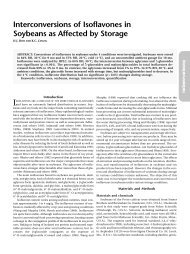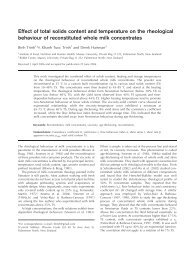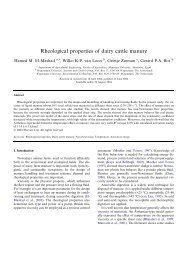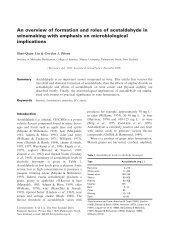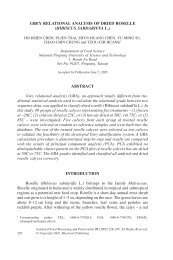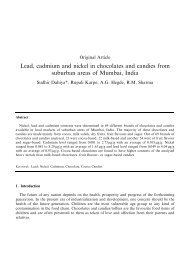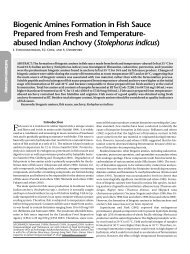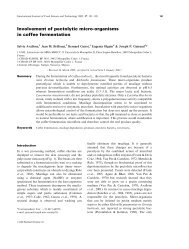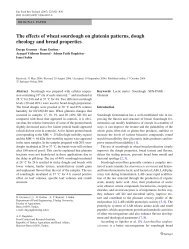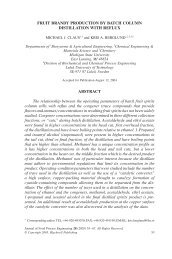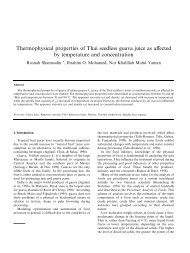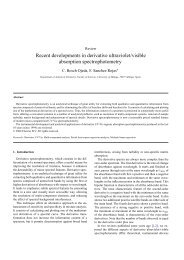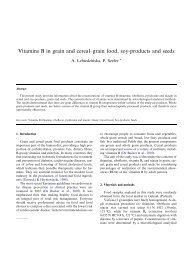Determination of Mechanism of Flock Sediment Formation in Tea ...
Determination of Mechanism of Flock Sediment Formation in Tea ...
Determination of Mechanism of Flock Sediment Formation in Tea ...
Create successful ePaper yourself
Turn your PDF publications into a flip-book with our unique Google optimized e-Paper software.
<strong>Determ<strong>in</strong>ation</strong> <strong>of</strong> <strong>Mechanism</strong> <strong>of</strong> <strong>Flock</strong> <strong>Sediment</strong> <strong>Formation</strong> <strong>in</strong><br />
<strong>Tea</strong> Beverages<br />
HITOSHI NIINO,* ,† IWAO SAKANE, ‡ KAZUNORI OKANOYA, †<br />
SYUHEI KURIBAYASHI, † AND HITOSHI KINUGASA †<br />
Central Research Institute and Quality Control, ITO EN Ltd., 21 Mekami, Sagara-cho, Haibara-gun,<br />
Shizuoka, 421-0516, Japan<br />
The mechanism <strong>of</strong> sediment formation dur<strong>in</strong>g the storage <strong>of</strong> green tea beverage was <strong>in</strong>vestigated.<br />
Green tea extract was separated by Diaion HP-20 column chromatography, and a sediment-formation<br />
test was performed. Results showed that at least one compound <strong>of</strong> the substance caus<strong>in</strong>g flock<br />
sediment was conta<strong>in</strong>ed <strong>in</strong> each <strong>of</strong> the HP-20 nonadsorbed and adsorbed fractions. From the follow<strong>in</strong>g<br />
fractionations and structure analyses, the substance <strong>in</strong> the HP-20 adsorbed fraction was determ<strong>in</strong>ed<br />
to be 1-O-galloyl-4,6-O-(S)-hexahydroxydiphenoyl--D-glucose (strict<strong>in</strong><strong>in</strong>), which is one <strong>of</strong> the<br />
ellagitann<strong>in</strong>s. Strict<strong>in</strong><strong>in</strong> was hydrolyzed to ellagic acid by heat-sterilization processes such as retort<br />
sterilization or the ultra-high temperature process<strong>in</strong>g used dur<strong>in</strong>g the manufactur<strong>in</strong>g <strong>of</strong> tea beverages.<br />
Ellagic acid comb<strong>in</strong>ed with prote<strong>in</strong>s <strong>in</strong> the HP-20 nonadsorbed fraction to form an irreversible sediment<br />
<strong>of</strong> green tea beverage; ellagic acid and prote<strong>in</strong>s were confirmed to be present <strong>in</strong> that sediment. The<br />
HP-20 adsorbed fraction conta<strong>in</strong>ed little strict<strong>in</strong><strong>in</strong> and formed hardly any sediment, suggest<strong>in</strong>g that<br />
control <strong>of</strong> the strict<strong>in</strong><strong>in</strong> content is significant <strong>in</strong> avoid<strong>in</strong>g sediment formation dur<strong>in</strong>g the manufactur<strong>in</strong>g<br />
process <strong>of</strong> tea beverages.<br />
KEYWORDS: <strong>Tea</strong> beverage; green tea; jasm<strong>in</strong>e tea; sediment formation; strict<strong>in</strong><strong>in</strong>; prote<strong>in</strong><br />
INTRODUCTION<br />
Nowadays, tea beverages such as green (nonfermented) tea,<br />
oolong (semifermented) tea, black (fermented) tea, and jasm<strong>in</strong>e<br />
(light-fermented) tea, tightly packed <strong>in</strong> cans or plastic bottles,<br />
cont<strong>in</strong>ue to be manufactured <strong>in</strong> Japan. Green and jasm<strong>in</strong>e tea<br />
beverages show traces <strong>of</strong> flock, float<strong>in</strong>g, or turbid white<br />
suspended matter or <strong>of</strong> sediment that occurs dur<strong>in</strong>g storage, all<br />
<strong>of</strong> which pose problems <strong>in</strong> the manufacture <strong>of</strong> these beverages.<br />
This sediment is occasionally found even when these teas are<br />
processed with a filter below 1 µm. When such sediment occurs,<br />
especially <strong>in</strong> tea beverages <strong>in</strong> clear bottles, their marketability<br />
will suffer due to the unpleasant visual impression. However,<br />
no established consensus exists on the mechanisms underly<strong>in</strong>g<br />
sediment formation <strong>in</strong> green and jasm<strong>in</strong>e tea beverages.<br />
Therefore, <strong>in</strong> manufactur<strong>in</strong>g the tea beverage, materials are<br />
selected which had been proven by prelim<strong>in</strong>ary test<strong>in</strong>g not to<br />
cause sedimentation <strong>in</strong> the beverage.<br />
The sediments result<strong>in</strong>g from <strong>in</strong>fusions <strong>of</strong> oolong (1, 2) and<br />
black (3-7) tea have reportedly been associated with oxidized<br />
polyphenols, catech<strong>in</strong>s, caffe<strong>in</strong>e, and prote<strong>in</strong>s and are called tea<br />
cream. The major monomeric catech<strong>in</strong>s <strong>of</strong> tea leaves are (-)epigallocatech<strong>in</strong><br />
gallate (EGCG), (-)-epicatech<strong>in</strong> gallate (ECG),<br />
(-)-epigallocatech<strong>in</strong> (EGC), (-)-epicatech<strong>in</strong> (EC), and (-)-<br />
* To whom correspondence should be addressed. Telephone: +81-548-<br />
54-1247. Fax: +81-548-54-0763. E-mail: h-n<strong>in</strong>o@itoen.co.jp.<br />
† Central Research Institute.<br />
‡ Quality Control.<br />
gallocatech<strong>in</strong> gallate (GCG), compris<strong>in</strong>g about 10-20% <strong>of</strong> the<br />
product’s dry weight. This tea cream differs from the sediments<br />
<strong>of</strong> green and jasm<strong>in</strong>e tea beverages generated when they are<br />
stored above room temperature s<strong>in</strong>ce tea cream occurs when<br />
the teas are processed <strong>in</strong> concentrated form. It has been<br />
orig<strong>in</strong>ally suspected that some oxidized polyphenols gradually<br />
bound with caffe<strong>in</strong>e, prote<strong>in</strong>s, pect<strong>in</strong>, or other polysaccharides<br />
by the catalytic action <strong>of</strong> metal ions to form complexes.<br />
The objective <strong>of</strong> this study was to determ<strong>in</strong>e the precise<br />
substances caus<strong>in</strong>g flock sediment formation follow<strong>in</strong>g the heat<br />
sterilization <strong>of</strong> green tea beverages. To determ<strong>in</strong>e the relevant<br />
components, green tea extract was separated and the responsible<br />
phenolic compound was then isolated and identified.<br />
MATERIALS AND METHODS<br />
Materials. The green tea used <strong>in</strong> this study was a commercially<br />
ref<strong>in</strong>ed tea (high-grade tea; Itoen, Ltd., Tokyo, Japan). Ellagic acid<br />
was purchased from Wako Pure Chemical Industries, (Osaka, Japan)<br />
and bov<strong>in</strong>e serum album<strong>in</strong> (BSA) from Sigma-Aldrich Co., (St. Louis,<br />
MO). All chemicals were <strong>of</strong> reagent grade.<br />
Extraction and Manufacture <strong>of</strong> Green <strong>Tea</strong> Beverage. A20g<br />
amount <strong>of</strong> ref<strong>in</strong>ed green tea (Camellia s<strong>in</strong>ensis, first flush) was extracted<br />
<strong>in</strong> 800 mL <strong>of</strong> distilled water at 70 °C for 3.5 m<strong>in</strong> with moderate<br />
agitation. Leaves were removed by a mesh sieve <strong>of</strong> 100 µm pore size<br />
and quickly cooled to 30 °C. The result<strong>in</strong>g extract was centrifuged at<br />
3000g for 10 m<strong>in</strong> to remove the <strong>in</strong>soluble components. The supernatant<br />
was added to ascorbic acid (f<strong>in</strong>al concentration, 500 µg/mL), adjusted<br />
to pH 6.0 with NaHCO3, poured <strong>in</strong>to a heat-resistant bottle, and heated<br />
<strong>in</strong> an autoclave at 121 °C for 7 m<strong>in</strong>.
Process<strong>in</strong>g <strong>of</strong> Green <strong>Tea</strong> Extract. After the above centrifugation,<br />
the supernatant was separated by pass<strong>in</strong>g through a column (160 × 52<br />
mm i.d.) filled with a highly porous polystyrene gel (Diaion HP-20,<br />
Mitsubishi Chemical Co., Tokyo, Japan). Nonadsorbed fraction was<br />
used for the experiments. The column was washed first with distilled<br />
water and successively eluted with 20, 40, 60, and 100% methanol.<br />
The fractions produc<strong>in</strong>g significant levels <strong>of</strong> sediment were then passed<br />
through a column (80 × 55 mm) filled with Cosmosil 75C18opn<br />
reverse-phase res<strong>in</strong> (Nacalai Tesque Inc., Kyoto, Japan) and successively<br />
eluted with 10, 20, and 30% methanol.<br />
These fractions were further fractionated by preparative HPLC with<br />
a 250 × 20 mm i.d. Wakosil-II 5C 18HG Prep reverse-phase column<br />
(Wako). The mobile phase was 22% methanol conta<strong>in</strong><strong>in</strong>g 0.1% acetic<br />
acid with a flow rate <strong>of</strong> 8 mL/m<strong>in</strong> at room temperature. The target<br />
compound was identified us<strong>in</strong>g FAB MS and 1 H and 13 C NMR. Mass<br />
spectra (MS) were obta<strong>in</strong>ed us<strong>in</strong>g a JEOL JMS-SX 102 mass<br />
spectrometer (JEOL Ltd., Tokyo, Japan). 1 H and 13 C NMR spectra<br />
were recorded on a JEOL JNM-A 400 (400.0 and 100.4 MHz; JEOL),<br />
and chemical shifts are given <strong>in</strong> δ (ppm) with tetramethylsilane used<br />
as an <strong>in</strong>ternal standard.<br />
<strong>Sediment</strong>-<strong>Formation</strong> Test. The brix value <strong>of</strong> extracts was measured<br />
by a DD-7 differential refractometer (Atago Co., Ltd., Tokyo, Japan).<br />
A f<strong>in</strong>al volume <strong>of</strong> 250 mL <strong>of</strong> the mixture conta<strong>in</strong><strong>in</strong>g 100 mL <strong>of</strong> the<br />
HP-20 nonadsorbed fraction (brix 0.4%), 0.125 g <strong>of</strong> ascorbic acid, and<br />
each eluate, respectively, was adjusted to pH 6.0 with NaHCO3, poured<br />
<strong>in</strong>to a heat-resistant bottle, and heated <strong>in</strong> an autoclave at 121 °C for 7<br />
m<strong>in</strong>. Samples were stored at 37 °C and observed for the formation <strong>of</strong><br />
flock sediment.<br />
HPLC Conditions. The determ<strong>in</strong>ation <strong>of</strong> phenolic compounds and<br />
the derivatives was carried out us<strong>in</strong>g a Hitachi Model D-7000 HPLC<br />
equipped with a L-7100 pump, a programmable L-7250 autosampler,<br />
and D-7000 chromatography data station s<strong>of</strong>tware (Hitachi, Ltd, Tokyo,<br />
Japan). Separation was done on a 250 × 4.6 mm i.d. Wakosil-II 5C18<br />
HG reverse-phase column (Wako). Mobile phase A was 15% methanol<br />
conta<strong>in</strong><strong>in</strong>g 0.1% phosphoric acid, and mobile phase B was 45%<br />
methanol conta<strong>in</strong><strong>in</strong>g 0.1% phosphoric acid. The gradient elution system<br />
was as follows: 0-18 m<strong>in</strong>, 100% A; 18.1-33 m<strong>in</strong>, 100% B; 33.1-45<br />
m<strong>in</strong>, 100% A. All analyses were carried out at 40 °C. The flow was<br />
kept constant at 0.6 mL/m<strong>in</strong> at 40 °C, and the eluents were monitored<br />
by a Hitachi L-7420 UV/vis detector at 280 nm.<br />
Collection <strong>of</strong> <strong>Flock</strong> <strong>Sediment</strong>, and Hydrolysis. The flock sediment<br />
<strong>of</strong> green tea beverage was collected us<strong>in</strong>g the method <strong>of</strong> Garrido et al.<br />
(8) with a slight modification. Briefly, it was collected by filter<strong>in</strong>g green<br />
tea beverage through a 0.45 µm cellulose acetate filter (Advantec MFS<br />
Inc., Tokyo, Japan) with a vacuum. The filter was washed with distilled<br />
water to remove water-soluble compounds, immersed <strong>in</strong> methanol <strong>in</strong> a<br />
heat-resistant bottle, and sonicated until the sediment peeled <strong>of</strong>f. The<br />
methanol extract was brought to a f<strong>in</strong>al volume <strong>of</strong> 100 mL, acidified<br />
with 100 µL HCl, and autoclaved at 121 °C for 7 m<strong>in</strong>. Phenolic<br />
compounds were analyzed us<strong>in</strong>g the above HPLC conditions.<br />
SDS-PAGE. The prote<strong>in</strong>s <strong>in</strong> the green tea extract were precipitated<br />
with 80% ethanol, and the precipitate was resolved with distilled water.<br />
The result<strong>in</strong>g solution was treated with 15% trichloroacetic acid (9)<br />
removed when the residues were washed with acetone dissolved with<br />
a sample buffer conta<strong>in</strong><strong>in</strong>g 20% glycerol, 50 mM 2-am<strong>in</strong>o-2-(hydroxymethyl)-1,3-propanediol,<br />
0.01% bromophenol blue, 1% sodium dodecyl<br />
sulfate (SDS), and 1% 2-mercaptoethanol; pH 6.8. After the hydrolysis<br />
<strong>of</strong> methanol extracts with HCl, the flock sediment was concentrated<br />
by a rotary evaporator and washed with methanol to remove HCl. The<br />
residues were dissolved with the sample buffer. Each sample was<br />
monitored by SDS-polyacrylamide gel electrophoresis (SDS-PAGE)<br />
us<strong>in</strong>g a 5-20% gradient gel (Pagel NPG-520L, Atto Co., Tokyo, Japan).<br />
The prote<strong>in</strong>s were visualized by sta<strong>in</strong><strong>in</strong>g with a silver-sta<strong>in</strong> kit (2D-<br />
Silver Sta<strong>in</strong> II; Daiichi Pure Chemicals, Tokyo, Japan).<br />
RESULT AND DISCUSSION<br />
Extraction and Fractionation with HP-20. The ref<strong>in</strong>ed<br />
green tea was extracted and the supernatant liquid passed<br />
through a column filled with Diaion HP-20 to obta<strong>in</strong> the HP-<br />
20 adsorption fraction. Then, the column was eluted with 80%<br />
Table 1. <strong>Sediment</strong>-<strong>Formation</strong> Test <strong>of</strong> HP-20 Fractions<br />
samples 1 week 2 weeks 3 weeks 4 weeks<br />
nonadsorbed fraction (A) − − − −<br />
80% methanol fraction (B) − − − −<br />
(A) + (B) + + + +<br />
a −, no sediment; +, sediment formed.<br />
Figure 1. Extraction and isolation <strong>of</strong> green tea extract to determ<strong>in</strong>e the<br />
relevant components <strong>of</strong> flock sediment.<br />
Figure 2. Chemical structures <strong>of</strong> strict<strong>in</strong><strong>in</strong> and ellagic acid.<br />
methanol to obta<strong>in</strong> the HP-20 80% methanol fraction. The<br />
sediment-formation test was carried out as <strong>in</strong> the abovedescribed<br />
experiments.<br />
As shown <strong>in</strong> Table 1, the occurrence <strong>of</strong> flock sediment was<br />
observed only <strong>in</strong> the HP-20 nonadsorbed fraction added to the<br />
80% methanol fraction. These f<strong>in</strong>d<strong>in</strong>gs showed that at least one<br />
component <strong>of</strong> the substance caus<strong>in</strong>g flock sediment was<br />
conta<strong>in</strong>ed <strong>in</strong> each <strong>of</strong> the HP-20 nonadsorbed fractions and the<br />
HP-20 adsorbed 80% methanol fraction.<br />
The sediment component conta<strong>in</strong>ed <strong>in</strong> the HP-20 adsorbed<br />
fraction was isolated. An outl<strong>in</strong>e <strong>of</strong> the work<strong>in</strong>g procedure <strong>of</strong><br />
this isolation is shown <strong>in</strong> Figure 1. The formation <strong>of</strong> flock<br />
sediment was observed <strong>in</strong> the HP-20 20 and 40% methanol<br />
fractions. The ma<strong>in</strong> catech<strong>in</strong> component <strong>of</strong> the 20% methanol<br />
fraction was EGC. Other major catech<strong>in</strong>s (EGCG, ECG, EC,<br />
and GCG) and caffe<strong>in</strong>e abounded <strong>in</strong> the 40% methanol fraction.<br />
S<strong>in</strong>ce the formation amount <strong>of</strong> sediment formed, especially <strong>in</strong><br />
the former, was high, the 20% methanol fraction was then<br />
separated by the ODS column and preparative HPLC. The<br />
sediment-formation test was repeated for each <strong>of</strong> the six peaks<br />
obta<strong>in</strong>ed by preparative HPLC, and sediment formation was<br />
observed <strong>in</strong> peak 3. This compound was purified and obta<strong>in</strong>ed<br />
as an amorphous white powder. From the 1 H and 13 C NMR<br />
and FAB MS, its structure was found to correspond to that <strong>of</strong><br />
1-O-galloyl-4,6-O-(S)-hexahydroxydiphenoyl--D-glucose (strict<strong>in</strong><strong>in</strong>),<br />
which was consistent with the previously reported data<br />
(10-12). Strict<strong>in</strong><strong>in</strong> (Figure 2) is one <strong>of</strong> the ellagitann<strong>in</strong>s<br />
extracted from tea, compris<strong>in</strong>g about 0-1.0% <strong>of</strong> its dry weight.<br />
As for the 40% methanol fraction <strong>of</strong> the HP-20 column, when<br />
the same identification as the above was obta<strong>in</strong>ed, it also
Figure 3. HPLC pr<strong>of</strong>iles <strong>of</strong> strict<strong>in</strong><strong>in</strong> <strong>in</strong> green tea extract. Chromatograms<br />
show<strong>in</strong>g changes <strong>in</strong> the strict<strong>in</strong><strong>in</strong> peak before (A) and after (B) heat<br />
sterilization. A peak (15.2 µg/mL) appeared at a retention time <strong>of</strong> about<br />
19 m<strong>in</strong> (A). This peak was elim<strong>in</strong>ated by heat sterilization.<br />
conta<strong>in</strong>ed strict<strong>in</strong><strong>in</strong>. In addition, no components other than<br />
strict<strong>in</strong><strong>in</strong> <strong>in</strong> that fraction were <strong>in</strong>volved <strong>in</strong> sediment formation.<br />
Characteristic Property <strong>of</strong> Strict<strong>in</strong><strong>in</strong> <strong>in</strong> Beverage Process<strong>in</strong>g.<br />
Green tea extract (brix 0.3%) conta<strong>in</strong><strong>in</strong>g 500 ppm ascorbic<br />
acid was sterilized at 121 °C for 7 m<strong>in</strong>. Strict<strong>in</strong><strong>in</strong> concentrations<br />
before and after heat sterilization were analyzed by HPLC. The<br />
peak appear<strong>in</strong>g at a retention time <strong>of</strong> about 19 m<strong>in</strong> was<br />
determ<strong>in</strong>ed by the absolute calibration method with the purified<br />
strict<strong>in</strong><strong>in</strong>.<br />
As shown <strong>in</strong> Figure 3, the content <strong>of</strong> 15.2 µg/mL strict<strong>in</strong><strong>in</strong><br />
was supposedly decomposed or precipitated by heat sterilization.<br />
S<strong>in</strong>ce the strict<strong>in</strong><strong>in</strong> conta<strong>in</strong>ed <strong>in</strong> the tea extract was completely<br />
decomposed under a heat-sterilization process such as retort or<br />
ultra-high temperature that is typically <strong>in</strong>volved <strong>in</strong> the manufacture<br />
<strong>of</strong> tea beverages, hardly any strict<strong>in</strong><strong>in</strong> would rema<strong>in</strong> <strong>in</strong><br />
beverages sold publicly.<br />
Figure 4. HPLC pr<strong>of</strong>iles <strong>of</strong> strict<strong>in</strong><strong>in</strong> aqueous solution after heat<br />
sterilization. Chromatograms show<strong>in</strong>g changes <strong>in</strong> the strict<strong>in</strong><strong>in</strong> solution<br />
(9.5 µg/mL) before (A) and after (B) heat sterilization. Strict<strong>in</strong><strong>in</strong> was<br />
elim<strong>in</strong>ated, and ellagic acid (2.8 µg/mL) appeared after heat sterilization.<br />
GA, gallic acid; EA, ellagic acid.<br />
Hydrolysis <strong>of</strong> Strict<strong>in</strong><strong>in</strong> with Heat Sterilization. Ellagitann<strong>in</strong>s<br />
are known to be hydrolyzed by treatment with an acid, a<br />
base, or heat, thus liberat<strong>in</strong>g ellagic acid (8, 13-19). Many fruits<br />
such as strawberries, raspberries, and grapes have been reported<br />
to conta<strong>in</strong> ellagitann<strong>in</strong>s, and the result<strong>in</strong>g ellagic acid was found<br />
to be the substance form<strong>in</strong>g the juice’s sediments (8, 15-19).<br />
The purified strict<strong>in</strong><strong>in</strong> was dissolved with distilled water and<br />
heat-sterilized at 121 °C for 7 m<strong>in</strong>. The chromatograms before<br />
and after heat sterilization are shown <strong>in</strong> Figure 4. Strict<strong>in</strong><strong>in</strong> was<br />
elim<strong>in</strong>ated after heat sterilization, and ellagic acid appeared at<br />
a retention time <strong>of</strong> about 40 m<strong>in</strong>. On the other hand, ellagic<br />
acid was hardly detectable after heat sterilization <strong>of</strong> the HP-20<br />
nonadsorbed fraction conta<strong>in</strong><strong>in</strong>g purified strict<strong>in</strong><strong>in</strong> (Figure 5).<br />
Thus, when a tea extract is sterilized, strict<strong>in</strong><strong>in</strong> decomposes to<br />
form ellagic acid, which b<strong>in</strong>ds with components conta<strong>in</strong>ed <strong>in</strong>
Figure 5. HPLC pr<strong>of</strong>iles <strong>of</strong> a mixed solution <strong>of</strong> strict<strong>in</strong><strong>in</strong> and the HP-20<br />
nonadsorbed fraction. Chromatograms show<strong>in</strong>g the changes <strong>in</strong> the mixed<br />
solution <strong>of</strong> strict<strong>in</strong><strong>in</strong> (9.1 µg/mL) and the HP-20 nonadsorbed fraction before<br />
(A) and after (B) heat sterilization. Strict<strong>in</strong><strong>in</strong> was elim<strong>in</strong>ated, and ellagic<br />
acid was hardly detectable after heat sterilization. GA, gallic acid.<br />
the HP-20 nonadsorbed fraction to form a precipitate, i.e., the<br />
flock sediment.<br />
Identification <strong>of</strong> Ellagic Acid <strong>in</strong> <strong>Flock</strong> <strong>Sediment</strong>. The flock<br />
sediment <strong>of</strong> 250 mL <strong>of</strong> green tea beverage was collected with<br />
a 0.45 µm cellulose acetate filter to identify the concentration<br />
<strong>of</strong> ellagic acid by HPLC (8). This sediment consisted <strong>of</strong> a dark<br />
green amorphous substance that proved to be <strong>in</strong>soluble <strong>in</strong> water,<br />
methanol, or ethanol. The ellagic acid <strong>in</strong> the sediment extracted<br />
by 100 mL <strong>of</strong> methanol had a concentration <strong>of</strong> only 0.3 µg/<br />
mL. S<strong>in</strong>ce it was thought to be <strong>in</strong>soluble <strong>in</strong> methanol, this<br />
solvent was acidified with 100 µL <strong>of</strong> HCl. More ellagic acid<br />
was liberated by methanol-HCl hydrolysis from the sediment<br />
at a concentration <strong>of</strong> 10.0 µg/mL. However, there was no further<br />
remarkable <strong>in</strong>crease follow<strong>in</strong>g severe hydrolysis by autoclave<br />
at 121 °C for 7 m<strong>in</strong> (12.0 µg/mL). In each stage <strong>of</strong> this study,<br />
<strong>in</strong>soluble materials appeared, <strong>in</strong>dicat<strong>in</strong>g that some <strong>in</strong>soluble<br />
materials were also constituents <strong>of</strong> flock sediment.<br />
Identification <strong>of</strong> Prote<strong>in</strong> <strong>in</strong> <strong>Flock</strong> <strong>Sediment</strong>. Some k<strong>in</strong>ds<br />
<strong>of</strong> prote<strong>in</strong>s <strong>in</strong> green tea beverage and its flock sediment were<br />
identified with SDS-PAGE. This precipitation, which removed<br />
ellagic acid by acid hydrolysis, could be dissolved <strong>in</strong> the sample<br />
buffer for SDS-PAGE, whereas the flock sediment <strong>of</strong> green<br />
tea beverage could not. The content <strong>of</strong> prote<strong>in</strong>s decreased after<br />
heat sterilization, show<strong>in</strong>g that some ellagic acid comb<strong>in</strong>ed with<br />
prote<strong>in</strong>s immediately after manufactur<strong>in</strong>g.<br />
In addition, both strict<strong>in</strong><strong>in</strong> and BSA (each at a f<strong>in</strong>al<br />
concentration <strong>of</strong> 10 µg/mL) were dissolved <strong>in</strong> distilled water<br />
and heat-sterilized at 121 °C for 7 m<strong>in</strong>. A large amount <strong>of</strong> flock<br />
sediment appeared immediately after heat sterilization, whereas<br />
each <strong>in</strong>dividual component failed to appear.<br />
The beverage <strong>in</strong>dustry has been faced with the occurrence<br />
<strong>of</strong> flock sediment while preserv<strong>in</strong>g tea beverages, especially <strong>in</strong><br />
green and jasm<strong>in</strong>e teas. It is desirable to avoid the formation <strong>of</strong><br />
flock sediment <strong>in</strong> these beverages s<strong>in</strong>ce it can be mistaken for<br />
mold propagat<strong>in</strong>g. To address this problem, the components <strong>of</strong><br />
green tea extracts were fractionated and sediment-formation tests<br />
were performed. It was determ<strong>in</strong>ed for the first time that<br />
strict<strong>in</strong><strong>in</strong> and prote<strong>in</strong>s <strong>in</strong> tea beverages were the substances<br />
caus<strong>in</strong>g flock sediment. It should be noted that strict<strong>in</strong><strong>in</strong> is<br />
hydrolyzed to yield ellagic acid under heat-sterilization treatment<br />
(e.g., by a retort or ultra-high temperature process<strong>in</strong>g) dur<strong>in</strong>g<br />
the manufacture <strong>of</strong> tea beverages. This liberated ellagic acid<br />
then comb<strong>in</strong>es with prote<strong>in</strong>s to form an irreversible sediment.<br />
The same mechanism was also confirmed <strong>in</strong> the manufacture<br />
<strong>of</strong> jasm<strong>in</strong>e tea beverage. When green tea leaves <strong>in</strong>volve a<br />
strict<strong>in</strong><strong>in</strong> amount <strong>of</strong> about 0.43% or more <strong>of</strong> its dry weight,<br />
flock sediment tended to occur, and jasm<strong>in</strong>e tea leaves tended<br />
to precipitate about 0.9% or more <strong>of</strong> its dry weight. The reason<br />
for the difference <strong>in</strong> the amount <strong>of</strong> strict<strong>in</strong><strong>in</strong> when flock sediment<br />
is formed with green tea beverage and jasm<strong>in</strong>e tea beverage is<br />
that <strong>in</strong> the jasm<strong>in</strong>e tea leaf manufactur<strong>in</strong>g process there is an<br />
odor-emitt<strong>in</strong>g phase from several hours’ accumulation <strong>of</strong> the<br />
green tea leaves and budd<strong>in</strong>g jasm<strong>in</strong>e flowers at 45 °C or less,<br />
<strong>in</strong> which process prote<strong>in</strong> is possibly denatured. The tea cream<br />
result<strong>in</strong>g from oolong and black tea beverages is associated<br />
ma<strong>in</strong>ly with catech<strong>in</strong>s and caffe<strong>in</strong>e, be<strong>in</strong>g different from flock<br />
sediment. There is only a little strict<strong>in</strong><strong>in</strong> <strong>in</strong> most oolong and<br />
black teas. These beverages failed to form flock sediment. Green<br />
tea is manufactured by steam<strong>in</strong>g or roast<strong>in</strong>g immediately after<br />
pluck<strong>in</strong>g the raw tea leaves to <strong>in</strong>activate the oxidative enzyme,<br />
and oolong and black teas are manufactured by fermentation<br />
with the enzymes <strong>of</strong> raw leaves. Strict<strong>in</strong><strong>in</strong> <strong>in</strong> the oolong and<br />
black tea was dissolved <strong>in</strong> the process <strong>of</strong> fermentation. The<br />
reason for the failure to form flock sediment <strong>in</strong> oolong and black<br />
tea beverages was thought to be that the strict<strong>in</strong><strong>in</strong>, and its<br />
derivatives were not extracted. Pect<strong>in</strong>, which is the ma<strong>in</strong><br />
polysaccharide <strong>in</strong> tea extract, has been thought to be one <strong>of</strong> the<br />
substances caus<strong>in</strong>g flock sediment (20). Polysaccharide <strong>in</strong> flock<br />
sediment was changed to methylglucoside by methanol-HCl<br />
hydrolysis at 95 °C for 5 h, and these trimethylsilyl derivatives<br />
were analyzed with GC-MS (21). However, s<strong>in</strong>ce there were<br />
few trimethylsilyl derivatives detected, we concluded that<br />
polysaccharides were not among the substances caus<strong>in</strong>g this<br />
sediment. Based on the sediment-formation test, none <strong>of</strong> the<br />
components <strong>in</strong> the fraction (except for strict<strong>in</strong><strong>in</strong>) were <strong>in</strong>volved<br />
<strong>in</strong> sediment formation, <strong>in</strong>dicat<strong>in</strong>g that ellagic acid derived from<br />
strict<strong>in</strong><strong>in</strong> was the ma<strong>in</strong> component <strong>of</strong> flock sediment. Moreover,<br />
green tea beverage manufactured from leaves that conta<strong>in</strong>ed<br />
hardly any strict<strong>in</strong><strong>in</strong> also failed to form flock sediment.
The content <strong>of</strong> hydrolyzable tann<strong>in</strong>s has been shown to<br />
undergo seasonal changes <strong>in</strong> the leaves <strong>of</strong> Liquidambar formosana<br />
(22) and Betula pubescens (23, 24). The strict<strong>in</strong><strong>in</strong> contents<br />
<strong>of</strong> tea leaves also undergo changes depend<strong>in</strong>g on factors such<br />
as the time <strong>of</strong> the harvest season and their growth level (data<br />
not shown). This result strongly suggested that such factors may<br />
control the sediment formation <strong>in</strong> tea beverages.<br />
S<strong>in</strong>ce the ellagitann<strong>in</strong> <strong>in</strong> the tea leaves was only a small<br />
amount <strong>of</strong> strict<strong>in</strong><strong>in</strong>, it was considered not to contribute to<br />
sedimentation <strong>in</strong> the tea beverage (12). In this study, strict<strong>in</strong><strong>in</strong><br />
was found at a level <strong>of</strong> 0.6% <strong>in</strong> the first-flush tea leaves used.<br />
Other hydrolyzable tann<strong>in</strong>s <strong>in</strong> the leaves <strong>of</strong> Camellia s<strong>in</strong>ensis<br />
have been identified as 1,4,6-tri-O-galloyl--D-glucose, 3-galloylqu<strong>in</strong>ic<br />
acid, 3-p-coumaroylqu<strong>in</strong>ic acid, 3-caffeoylqu<strong>in</strong>ic acid,<br />
5-caffeoylqu<strong>in</strong>ic acid, and 1-O-galloyl--D-glucose. Recently,<br />
a metabolic pathway <strong>of</strong> ellagitann<strong>in</strong>s has been proposed (25),<br />
and strict<strong>in</strong><strong>in</strong> has been synthesized via the pathway <strong>of</strong> 1,2,3,4,6penta-O-galloyl--D-glucose<br />
and tellimagrand<strong>in</strong> II. However, the<br />
strict<strong>in</strong><strong>in</strong> <strong>in</strong> tea leaves may derive from 1,4,6-tri-O-galloyl--<br />
D-glucose by the oxidative coupl<strong>in</strong>g <strong>of</strong> two gallic acid moieties<br />
enzymatically. In fact, the 1,4,6-tri-O-galloyl--D-glucose content<br />
was found to be significantly higher <strong>in</strong> some k<strong>in</strong>ds <strong>of</strong> firstflush<br />
leaves conta<strong>in</strong><strong>in</strong>g very little strict<strong>in</strong><strong>in</strong>.<br />
The precipitation observed <strong>in</strong> w<strong>in</strong>e and grape juice was found<br />
to conta<strong>in</strong> ellagic acid and was seen to be particles or needles<br />
rather than flock precipitation <strong>in</strong> many cases (17, 19). This is<br />
considered to be due to the fact that there are few prote<strong>in</strong>s <strong>in</strong><br />
the precipitation <strong>of</strong> grape juice or w<strong>in</strong>e s<strong>in</strong>ce both are acid<br />
beverages under pH 4.0 (8). Interest<strong>in</strong>gly, this k<strong>in</strong>d <strong>of</strong> precipitation<br />
also slightly appeared <strong>in</strong> acid green tea beverage (pH 3.5)<br />
that was acidified with ascorbic acid.<br />
The current study showed that strict<strong>in</strong><strong>in</strong> <strong>in</strong> tea extracts was<br />
hydrolyzed to yield ellagic acid under heat-sterilization and that<br />
flock sediment occurred when ellagic acid comb<strong>in</strong>ed with<br />
prote<strong>in</strong>s. High-temperature, high-pressure sterilization (e.g., by<br />
a retort or ultra-high temperature process<strong>in</strong>g) is <strong>in</strong>dispensable<br />
<strong>in</strong> the manufacture <strong>of</strong> neutral beverages (pH 5.0-7.0) to prevent<br />
the propagation <strong>of</strong> microbes. It is also necessary to control the<br />
strict<strong>in</strong><strong>in</strong> and prote<strong>in</strong> contents <strong>of</strong> tea beverages so as to avoid<br />
the formation <strong>of</strong> flock sediment.<br />
ACKNOWLEDGMENT<br />
We thank Kaoru Umehara, Department <strong>of</strong> Pharmacology,<br />
School <strong>of</strong> Pharmaceutical Sciences, University <strong>of</strong> Shizuoka, for<br />
the NMR and Fab MS analyses.<br />
LITERATURE CITED<br />
(1) Chao, Y. C.; Chiang, B. H. The roles <strong>of</strong> catech<strong>in</strong>s and caffe<strong>in</strong>e<br />
<strong>in</strong> cream formation <strong>in</strong> a semi-fermented tea. J. Sci. Food Agric.<br />
1999, 79, 1687-1690.<br />
(2) Chao, Y. C.; Chiang, B. H. Cream formation <strong>in</strong> a semifermented<br />
tea. J. Sci. Food Agric. 1999, 79, 1767-1774.<br />
(3) Roberts, E. A. H. The phenolic substances <strong>of</strong> manufactured tea.<br />
The cream<strong>in</strong>g down <strong>of</strong> tea liquors. J. Sci. Food Agric. 1963, 14,<br />
700-705.<br />
(4) Smith, R. F. Studies on the formation and composition <strong>of</strong> cream<br />
<strong>in</strong> tea <strong>in</strong>fusions. J. Sci. Food Agric. 1968, 19, 530-534.<br />
(5) Nagalakshimi, S.; Seshadri, R. A study <strong>of</strong> nitrogenous constituents<br />
<strong>of</strong> tea cream. J. Food Sci. Technol. 1983, 20, 243-245.<br />
(6) Seshadri, R.; Nagalakshimi, D. New hydrophobic lipid <strong>in</strong>teraction<br />
<strong>in</strong> tea cream. J. Sci. Food Agric. 1988, 45, 79-86.<br />
(7) Powell, C.; Clifford, M. N.; Opie, S. C.; Ford, M. A.; Robertson,<br />
A.; Gibson, C. L. <strong>Tea</strong> cream formation: The contribution <strong>of</strong><br />
black tea phenolic pigments determ<strong>in</strong>ed by HPLC. J. Sci. Food<br />
Agric. 1992, 63, 77-86.<br />
(8) Garrido, V. M.; Sims, C. A.; Marshall, M. R.; Bates, R. P. Factors<br />
<strong>in</strong>fluenc<strong>in</strong>g ellagic acid precipitation <strong>in</strong> muscad<strong>in</strong>e grape juice<br />
dur<strong>in</strong>g storage. J. Food Sci. 1993, 58, 193-196.<br />
(9) Bensadoun, A. Assay <strong>of</strong> prote<strong>in</strong>s <strong>in</strong> the presence <strong>of</strong> <strong>in</strong>terfer<strong>in</strong>g<br />
materials. Anal. Biochem. 1976, 70, 241-250.<br />
(10) Okuda, T.; Yoshida, T.; Ashida, M.; Yazaki, K. Casuari<strong>in</strong>,<br />
stachyur<strong>in</strong> and strict<strong>in</strong><strong>in</strong>, new ellagitann<strong>in</strong>s from Casuar<strong>in</strong>a<br />
stricta and Stachyurus praecox. Chem. Pharm. Bull. 1982, 30,<br />
766-769.<br />
(11) Okuda, T.; Yoshida, T.; Ashida, M.; Yazaki, K. Tann<strong>in</strong>s <strong>of</strong><br />
Casuar<strong>in</strong>a and Stachyurus species. Part 1. Structures <strong>of</strong> pedunculag<strong>in</strong>,<br />
casuarict<strong>in</strong>, strict<strong>in</strong><strong>in</strong>, casuar<strong>in</strong><strong>in</strong>, casuari<strong>in</strong>, and stachyur<strong>in</strong>.<br />
J. Chem. Soc., Perk<strong>in</strong> Trans. 1 1983, 1765-1772.<br />
(12) Nonaka, G.; Sakai, R.; Nishioka, I. Hydrolysable tann<strong>in</strong>s and<br />
proanthocyanid<strong>in</strong>s from green tea. Phytochemistry 1984, 23,<br />
1753-1755.<br />
(13) Daniel, E. M.; Krupnick, A. S.; Heur, Y.-H.; Bl<strong>in</strong>zler, J. A.;<br />
Nims, R. W.; Stoner, G. D. Extraction, stability, and quantitation<br />
<strong>of</strong> ellagic acid <strong>in</strong> various fruits and nuts. J. Food Compos. Anal.<br />
1989, 2, 338-349.<br />
(14) Rommel, A.; Wrolstad, R. E. Influence <strong>of</strong> acid and base<br />
hydrolysis on the phenolic composition <strong>of</strong> red raspberry juice.<br />
J. Agric. Food Chem. 1993, 41, 1237-1241.<br />
(15) Clliford, M. N.; Scalbert, A. Ellagitann<strong>in</strong>s-nature, occurrence and<br />
dietary burden. J. Sci. Food Agric. 2000, 80, 1118-1125.<br />
(16) Rommel, A.; Wrolstad, R. E. Ellagic acid content <strong>of</strong> red raspberry<br />
juice as <strong>in</strong>fluenced by cultivar, process<strong>in</strong>g, and environmental<br />
factors. J. Agric. Food Chem. 1993, 41, 1951-1960.<br />
(17) Boyle, J. A.; Hsu, L. Identification and quantitation <strong>of</strong> ellagic<br />
acid <strong>in</strong> muscad<strong>in</strong>e grape juice. Am. J. Enol. Vitic. 1990, 41,43-<br />
47.<br />
(18) S<strong>in</strong>gleton, V. L.; Marsh, G. L.; Coven, M. Identification <strong>of</strong> ellagic<br />
acid as a precipitate from loganberry w<strong>in</strong>e. J. Agric. Food Chem.<br />
1966, 14, 5-8.<br />
(19) L<strong>in</strong>, T. Y.; V<strong>in</strong>e, R. P. Identification and reduction <strong>of</strong> ellagic<br />
acid <strong>in</strong> muscad<strong>in</strong>e grape juice. J. Food Sci. 1990, 55, 1607-<br />
1619, 1613.<br />
(20) Takeo, T.; Unno, T.; K<strong>in</strong>ugasa, H.; Yayabe, F.; Motoyama, M.<br />
The chemical properties and functional effects <strong>of</strong> polysaccharides<br />
dissolved <strong>in</strong> green tea <strong>in</strong>fusion. Nippon Shokuh<strong>in</strong> Kagaku Kogaku<br />
Kaishi 1998, 45, 270-272.<br />
(21) Chapl<strong>in</strong>, M. F. A rapid and sensitive method for the analysis <strong>of</strong><br />
carbohydrate components <strong>in</strong> glycoprote<strong>in</strong>s us<strong>in</strong>g gas-liquid<br />
chromatography. Anal. Biochem. 1982, 123, 336-341.<br />
(22) Hatano, T.; Kira, R.; Yoshizaki, M.; Okuda, T. Seasonal changes<br />
<strong>in</strong> the tann<strong>in</strong>s <strong>of</strong> liquidambar formosana reflect<strong>in</strong>g their biogenesis.<br />
Phytochemistry 1986, 25, 2787-2789.<br />
(23) Ossipov, V.; Loponen, J.; Ossipova, S.; Haukioja, E.; Pihlaja,<br />
K. Gallotann<strong>in</strong>s <strong>of</strong> birch betula pubescens leaves: HPLC<br />
separation and quantification. Biochem. Syst. Ecol. 1997, 25,<br />
493-504.<br />
(24) Salm<strong>in</strong>en, J. P.; Ossipov, V.; Haukioja, E.; Pihlaja, K. Seasonal<br />
variation <strong>in</strong> the content <strong>of</strong> hydrolysable tann<strong>in</strong>s <strong>in</strong> leaves <strong>of</strong> betula<br />
pubescens. Phytochemistry 2001, 57, 15-22.<br />
(25) Haslam, E. Practical Polyphenolics; Cambridge University<br />
Press: Cambridge, U.K., 1998; pp 63-68.<br />
Received for review December 12, 2004. Revised manuscript received<br />
March 17, 2005. Accepted March 17, 2005.<br />
JF047904E



